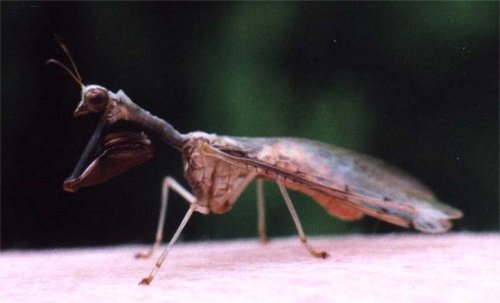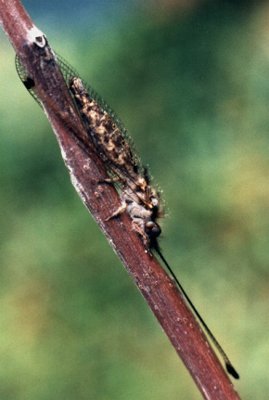Clear Wings
by Valerie (September 28, 2000)
revised November 4, 2002
 Several insects occurring in our gardens are members of the order Neuroptera, which means "nerve-winged" and refers to the patterns of veins on their wings. They all have four long, clear wings but they aren't very strong fliers. When discovered, they are more likely to remain motionless and inconspicuous rather than fly away.
Several insects occurring in our gardens are members of the order Neuroptera, which means "nerve-winged" and refers to the patterns of veins on their wings. They all have four long, clear wings but they aren't very strong fliers. When discovered, they are more likely to remain motionless and inconspicuous rather than fly away.
The first insect shown is the lacewing. This familiar little predator has beautiful, delicate iridescent wings and usually has a green body, but they are sometimes brown. It is often hard to see until it is so disturbed that it actually flies out of the foliage. The larvae are more often encountered, usually appearing in the middle of aphid infestations, where they gorge on the pests.
Most people have seen the little pits in dry sand that harbor "doodlebugs" and have probably even dug them out to get a good look at them. These are the larvae of the antlion, so called because the purpose of the larvae's pit is to trap ants for food, which are then devoured with relish. Antlion larvae look quite a bit like brown, fat versions of the lacewing larvae. The adult antlions are black and gray speckled and very slender. They hide by stretching out along a branch and I've sometimes been surprised by them flying up when I never saw them in their hiding places and almost inadvertently grabbed them along with the plants I was pruning.

A very interesting insect that I've seen only rarely is the brown mantisfly. This weird looking insect is named for its front appendages that resemble those of the praying mantis. The larvae of the mantisfly live in the nests of paper wasps and feed on their grubs. The adults are mimics of various species of wasps.
The last insect pictured here is an owlfly, named for its very large eyes. I had seen it quite often, but never known what it was until a helpful reader identified it. It is rather common in this area, is about two inches long, and resembles a robust sort of antlion. When disturbed, it lifts its abdomen in the air, perhaps to release a foul chemical (?). The larvae are similar to antlions but instead of digging pits, just cover themselves with debris to ambush prey.
|


